Recycle Mike's happy days 课件(25张PPT)
文档属性
| 名称 | Recycle Mike's happy days 课件(25张PPT) | 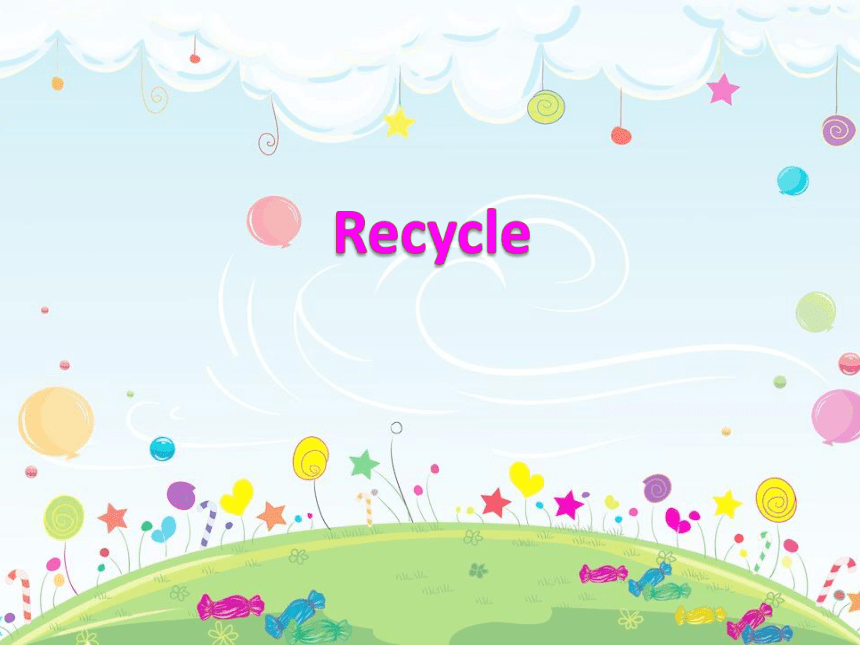 | |
| 格式 | zip | ||
| 文件大小 | 243.0KB | ||
| 资源类型 | 教案 | ||
| 版本资源 | 人教版(PEP) | ||
| 科目 | 英语 | ||
| 更新时间 | 2019-03-06 13:38:33 | ||
图片预览

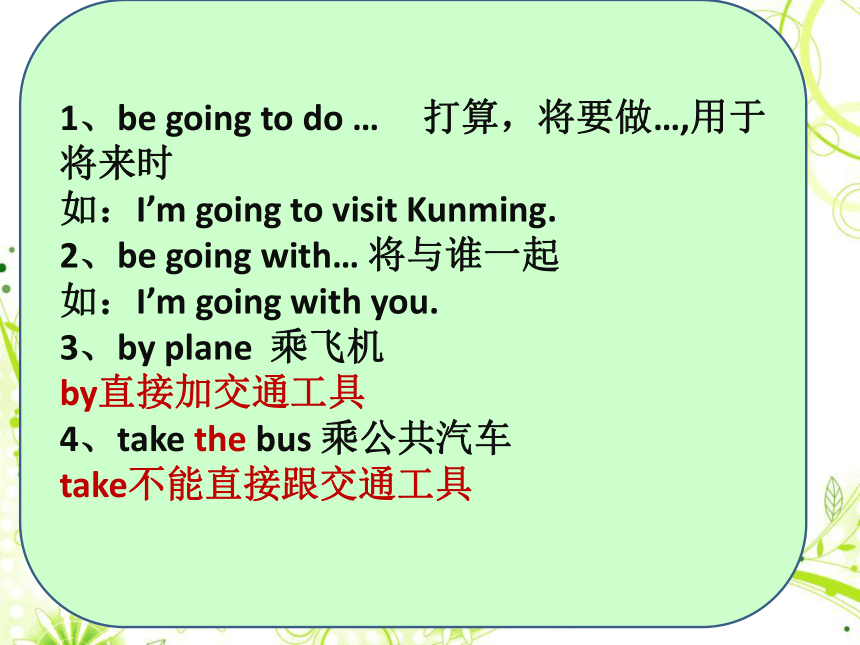
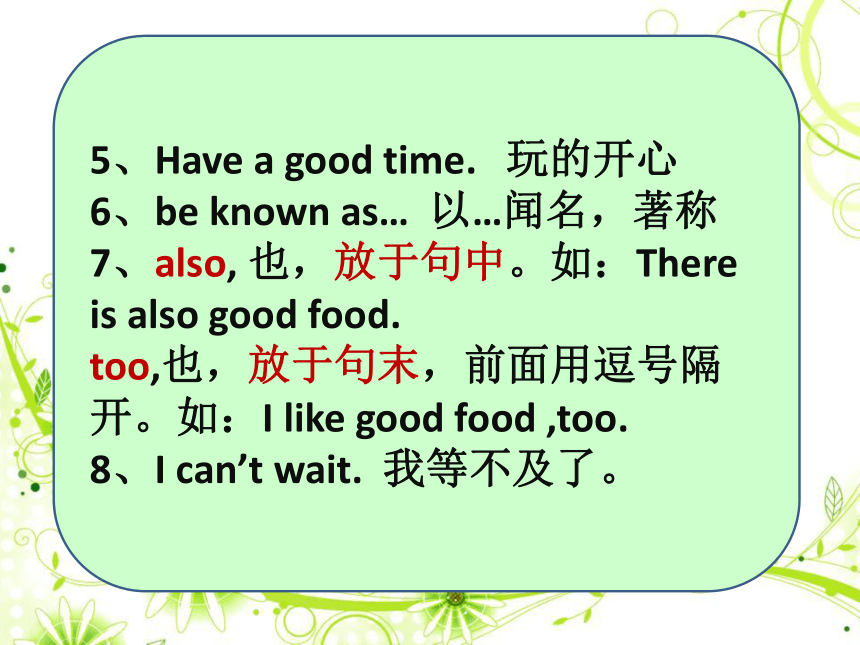
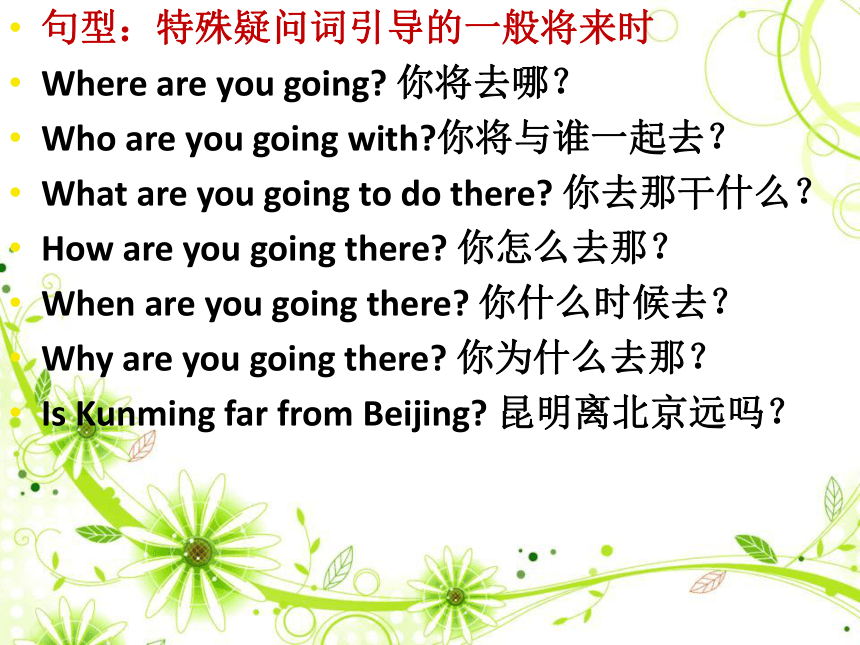
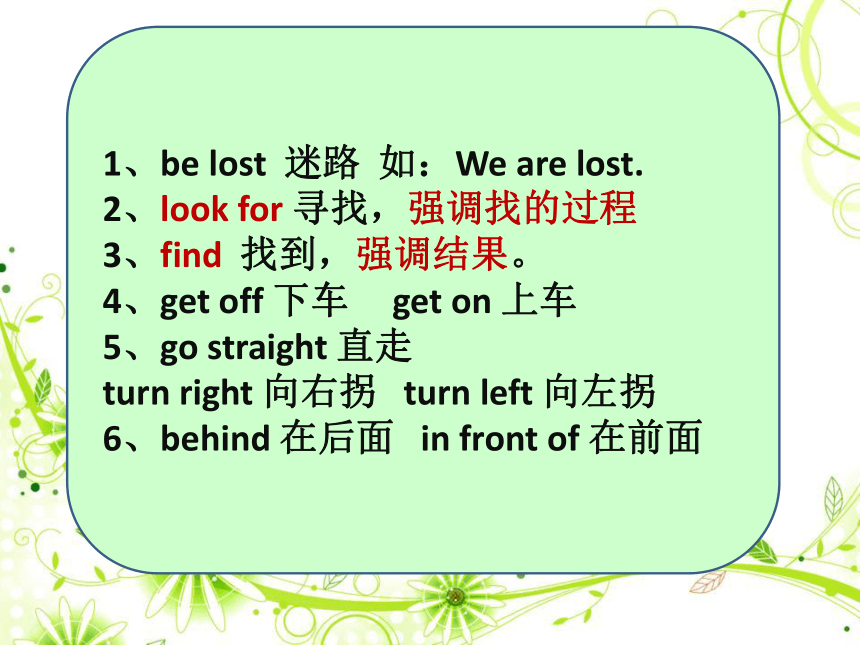
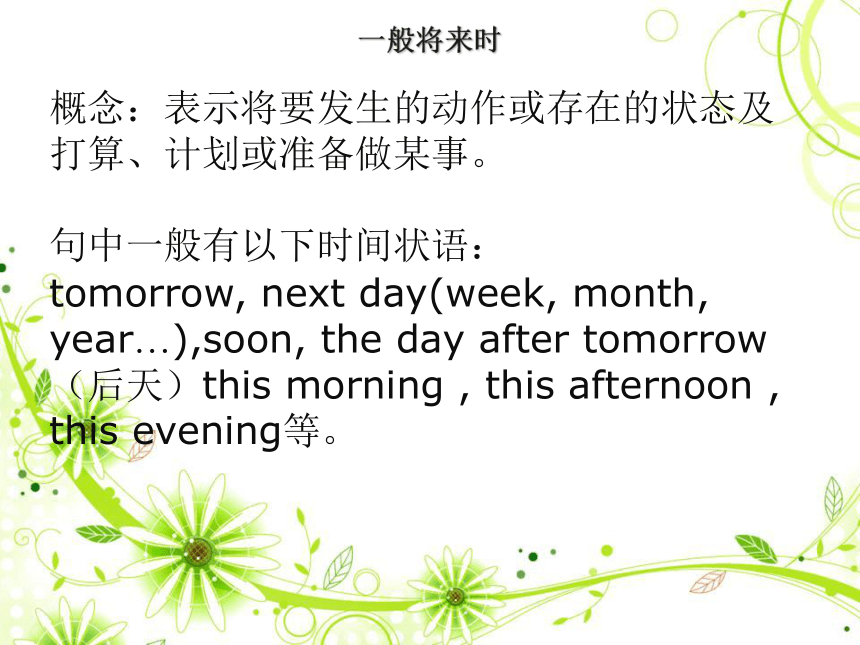
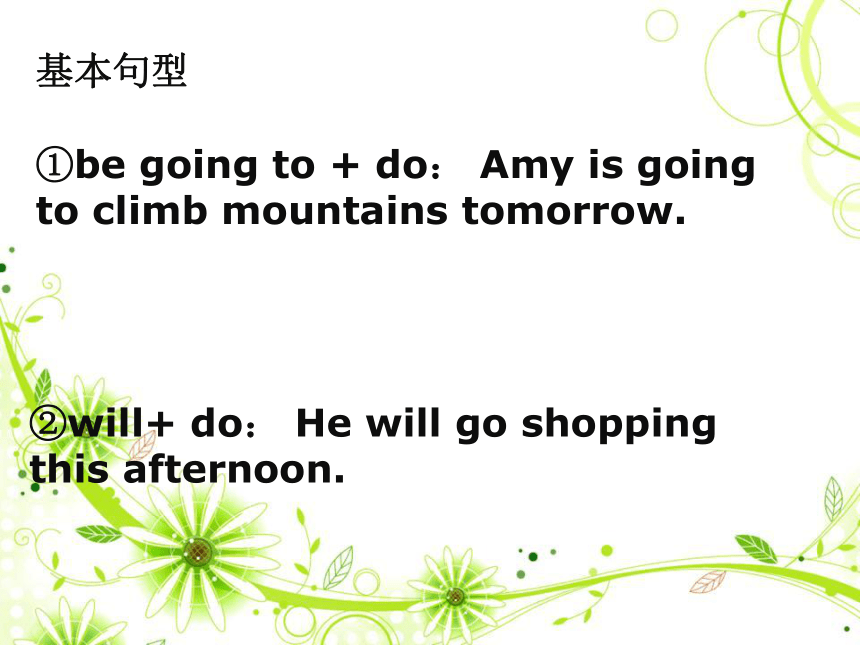
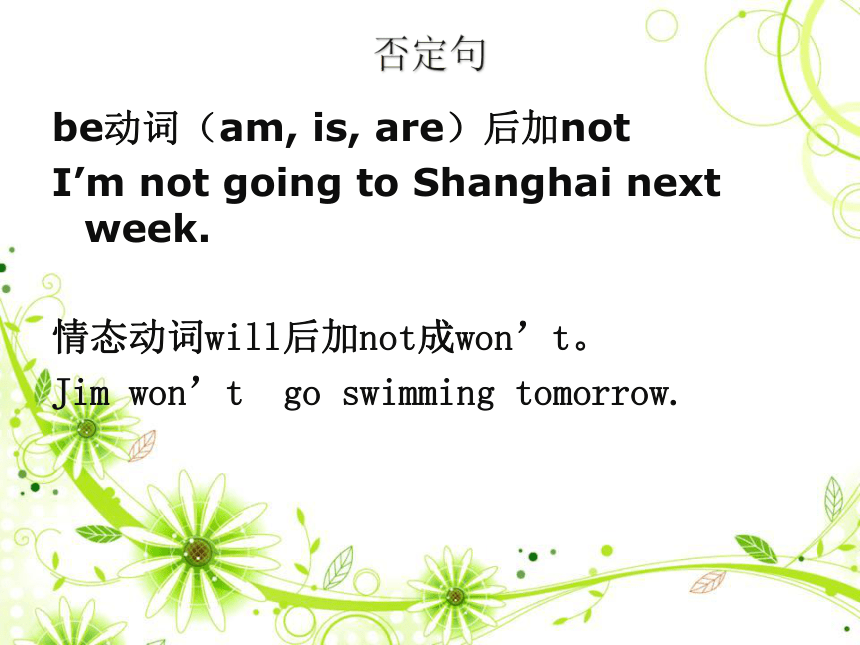

文档简介
课件25张PPT。Recycle1、be going to do … 打算,将要做…,用于将来时
如:I’m going to visit Kunming.
2、be going with… 将与谁一起
如:I’m going with you.
3、by plane 乘飞机
by直接加交通工具
4、take the bus 乘公共汽车
take不能直接跟交通工具
5、Have a good time. 玩的开心
6、be known as… 以…闻名,著称
7、also, 也,放于句中。如:There is also good food.
too,也,放于句末,前面用逗号隔开。如:I like good food ,too.
8、I can’t wait. 我等不及了。句型:特殊疑问词引导的一般将来时
Where are you going? 你将去哪?
Who are you going with?你将与谁一起去?
What are you going to do there? 你去那干什么?
How are you going there? 你怎么去那?
When are you going there? 你什么时候去?
Why are you going there? 你为什么去那?
Is Kunming far from Beijing? 昆明离北京远吗?
绿色圃中小学教育网http://www.Lspjy.com 绿色圃中学资源网http://cz.Lspjy.com1、be lost 迷路 如:We are lost.
2、look for 寻找,强调找的过程
3、find 找到,强调结果。
4、get off 下车 get on 上车
5、go straight 直走
turn right 向右拐 turn left 向左拐
6、behind 在后面 in front of 在前面一般将来时概念:表示将要发生的动作或存在的状态及打算、计划或准备做某事。
句中一般有以下时间状语:
tomorrow, next day(week, month, year…),soon, the day after tomorrow(后天)this morning , this afternoon , this evening等。
基本句型
①be going to + do: Amy is going to climb mountains tomorrow.
②will+ do: He will go shopping this afternoon. 否定句be动词(am, is, are)后加not
I’m not going to Shanghai next week.
情态动词will后加not成won’t。
Jim won’t go swimming tomorrow.一般疑问句把be 动词(或情态动词)提到句首,后面+主语+动词ing(动词原形)+其他
如:Are you going to Beijing next month?
Will you study English next class?绿色圃中小学教育网http://www.Lspjy.com 绿色圃中学资源网http://cz.Lspjy.com特殊疑问句特殊疑问词+be动词+主语+动词ing+其他
Where are you going on your holiday?
特殊疑问词+情态动词+主语+动词原形
What will you do there?练习 1.?? 我打算明天和朋友去野炊。 I_____ _______ _________ have a picnic with my friends. I ________ have a picnic with my friends.
2.?? 下个星期一你打算去干嘛? 我想去打篮球。 What ________ ________ _________ _________ _________ next Monday? I _______ ______ _____ play basketball. What _________ you do next Monday? I ________ play basketball.
3. 你妈妈这个周末去购物吗?是,她要去买一些水果。 _____ your mother _______ ________ go shopping this ___________? Yes, she _________. She ______ ________ __________ buy some fruit.
1、play the piano 弹钢琴 play后不能直接跟乐器
play football 踢足球 play 后直接跟球类单词
2、invite somebody to 邀请某人去
3、like doing 喜欢做某事(习惯、爱好)
4、in the future 在将来
5、 say goodbye to…跟谁说再见打电话用语
Who’s that?
This is Liu Yun speaking.你是谁?我是刘芸现在进行时
1.现在进行时表示现在正在进行或发生的动作,也可表示当前一段时间内的活动或现阶段正在进行的动作。
时间状语词:now, listen, look,或给出特定时间等。现在进行时的肯定句基本结构为be+动词ing.
John is dancing.
现在进行时的否定句在be后加not。
John isn’t dancing.绿色圃中小学教育网http://www.Lspjy.com 绿色圃中学资源网http://cz.Lspjy.com现在进行时的一般疑问句把be动词调到句首。
Is John dancing?
现在进行时的特殊疑问的基本结构为:特殊疑问词+ be + 主语 + 动词ing?
What is John doing?
动词加ing的变化规则 1.一般情况下,直接加ing,如:cook-cooking
2.以不发音的e结尾,去e加ing,如:make-making, taste-tasting take-taking
3.如果末尾是一个元音字母和一个辅音字母,双写末尾的辅音字母,再加ing,如:run-running, stop-stopping swim-swimming
用括号内所给动词的适当形式填空。
1. Look! The children ________ (swim) in the river.
2. Now we ________ (want) to play basketball.
3. -________ you ________ (draw) a picture?
-No, I'm not. I ________ (write) a letter.
are swimmingdrawingare wantingam writingAre
4.?What are you _________ (do) now? I
___________ (eat) bread.
5.???It’s nine o’clock. My
father____________ (work) in the office.
doingam eatingis working
1、There be 句型表示:在某地有某物(或人)
2、在there be 句型中,
主语是单数,be 动词用is ;
主语是复数,be 动词用are ;
如有几件物品,be 动词根据最靠近be 动词的那个名词决定(就近原则)。
3、there be 句型的否定句在be 动词后加not , 一般疑问句把be 动词调到句首。 4、some 和any 在there be 句型中的运用:some 用于肯定句, any 用于否定句或疑问句。there be句型与have(has) 的区别:
there be 表示在某地有某物(或人);
have(has) 表示某人拥有某物。绿色圃中小学教育网http://www.Lspjy.com 绿色圃中学资源网http://cz.Lspjy.com人称代词第一人称第二人称第三人称主格宾格单数复数单数复数Iwemeusyouyouyouyouhe/she/ittheyhim/her/itthem物主代词主格theyIyouhesheit形容词性物主代词myyourhisheritstheirweour名词性物主代词mineitshershisyourstheirsours指示代词:指近处指远处
单数this (这个)that (那个)
复数these(这些)those(那些)绿色圃中小学教育网http://www.Lspjy.com 绿色圃中学资源网http://cz.Lspjy.com
如:I’m going to visit Kunming.
2、be going with… 将与谁一起
如:I’m going with you.
3、by plane 乘飞机
by直接加交通工具
4、take the bus 乘公共汽车
take不能直接跟交通工具
5、Have a good time. 玩的开心
6、be known as… 以…闻名,著称
7、also, 也,放于句中。如:There is also good food.
too,也,放于句末,前面用逗号隔开。如:I like good food ,too.
8、I can’t wait. 我等不及了。句型:特殊疑问词引导的一般将来时
Where are you going? 你将去哪?
Who are you going with?你将与谁一起去?
What are you going to do there? 你去那干什么?
How are you going there? 你怎么去那?
When are you going there? 你什么时候去?
Why are you going there? 你为什么去那?
Is Kunming far from Beijing? 昆明离北京远吗?
绿色圃中小学教育网http://www.Lspjy.com 绿色圃中学资源网http://cz.Lspjy.com1、be lost 迷路 如:We are lost.
2、look for 寻找,强调找的过程
3、find 找到,强调结果。
4、get off 下车 get on 上车
5、go straight 直走
turn right 向右拐 turn left 向左拐
6、behind 在后面 in front of 在前面一般将来时概念:表示将要发生的动作或存在的状态及打算、计划或准备做某事。
句中一般有以下时间状语:
tomorrow, next day(week, month, year…),soon, the day after tomorrow(后天)this morning , this afternoon , this evening等。
基本句型
①be going to + do: Amy is going to climb mountains tomorrow.
②will+ do: He will go shopping this afternoon. 否定句be动词(am, is, are)后加not
I’m not going to Shanghai next week.
情态动词will后加not成won’t。
Jim won’t go swimming tomorrow.一般疑问句把be 动词(或情态动词)提到句首,后面+主语+动词ing(动词原形)+其他
如:Are you going to Beijing next month?
Will you study English next class?绿色圃中小学教育网http://www.Lspjy.com 绿色圃中学资源网http://cz.Lspjy.com特殊疑问句特殊疑问词+be动词+主语+动词ing+其他
Where are you going on your holiday?
特殊疑问词+情态动词+主语+动词原形
What will you do there?练习 1.?? 我打算明天和朋友去野炊。 I_____ _______ _________ have a picnic with my friends. I ________ have a picnic with my friends.
2.?? 下个星期一你打算去干嘛? 我想去打篮球。 What ________ ________ _________ _________ _________ next Monday? I _______ ______ _____ play basketball. What _________ you do next Monday? I ________ play basketball.
3. 你妈妈这个周末去购物吗?是,她要去买一些水果。 _____ your mother _______ ________ go shopping this ___________? Yes, she _________. She ______ ________ __________ buy some fruit.
1、play the piano 弹钢琴 play后不能直接跟乐器
play football 踢足球 play 后直接跟球类单词
2、invite somebody to 邀请某人去
3、like doing 喜欢做某事(习惯、爱好)
4、in the future 在将来
5、 say goodbye to…跟谁说再见打电话用语
Who’s that?
This is Liu Yun speaking.你是谁?我是刘芸现在进行时
1.现在进行时表示现在正在进行或发生的动作,也可表示当前一段时间内的活动或现阶段正在进行的动作。
时间状语词:now, listen, look,或给出特定时间等。现在进行时的肯定句基本结构为be+动词ing.
John is dancing.
现在进行时的否定句在be后加not。
John isn’t dancing.绿色圃中小学教育网http://www.Lspjy.com 绿色圃中学资源网http://cz.Lspjy.com现在进行时的一般疑问句把be动词调到句首。
Is John dancing?
现在进行时的特殊疑问的基本结构为:特殊疑问词+ be + 主语 + 动词ing?
What is John doing?
动词加ing的变化规则 1.一般情况下,直接加ing,如:cook-cooking
2.以不发音的e结尾,去e加ing,如:make-making, taste-tasting take-taking
3.如果末尾是一个元音字母和一个辅音字母,双写末尾的辅音字母,再加ing,如:run-running, stop-stopping swim-swimming
用括号内所给动词的适当形式填空。
1. Look! The children ________ (swim) in the river.
2. Now we ________ (want) to play basketball.
3. -________ you ________ (draw) a picture?
-No, I'm not. I ________ (write) a letter.
are swimmingdrawingare wantingam writingAre
4.?What are you _________ (do) now? I
___________ (eat) bread.
5.???It’s nine o’clock. My
father____________ (work) in the office.
doingam eatingis working
1、There be 句型表示:在某地有某物(或人)
2、在there be 句型中,
主语是单数,be 动词用is ;
主语是复数,be 动词用are ;
如有几件物品,be 动词根据最靠近be 动词的那个名词决定(就近原则)。
3、there be 句型的否定句在be 动词后加not , 一般疑问句把be 动词调到句首。 4、some 和any 在there be 句型中的运用:some 用于肯定句, any 用于否定句或疑问句。there be句型与have(has) 的区别:
there be 表示在某地有某物(或人);
have(has) 表示某人拥有某物。绿色圃中小学教育网http://www.Lspjy.com 绿色圃中学资源网http://cz.Lspjy.com人称代词第一人称第二人称第三人称主格宾格单数复数单数复数Iwemeusyouyouyouyouhe/she/ittheyhim/her/itthem物主代词主格theyIyouhesheit形容词性物主代词myyourhisheritstheirweour名词性物主代词mineitshershisyourstheirsours指示代词:指近处指远处
单数this (这个)that (那个)
复数these(这些)those(那些)绿色圃中小学教育网http://www.Lspjy.com 绿色圃中学资源网http://cz.Lspjy.com
